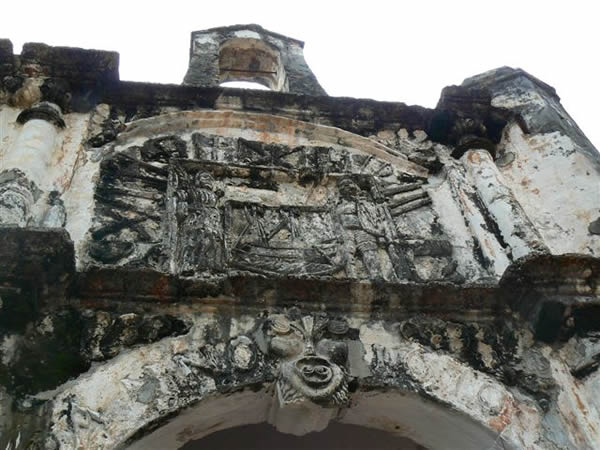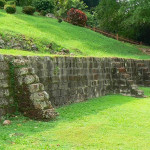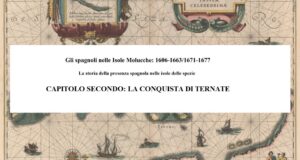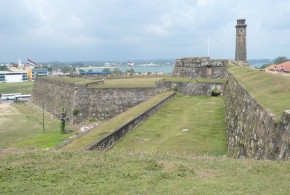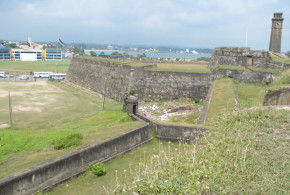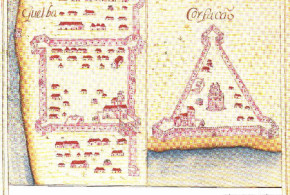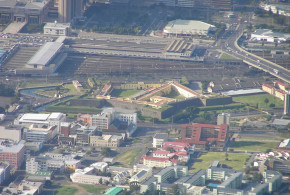Written by Marco Ramerini. Photos by Krzysztof Kudlek. English text revision by Dietrich Köster.
The city of Malacca was conquered by the Portuguese in 1511. Soon after the conquest of the city, which was the most important commercial port in Asia, Afonso de Albuquerque built a fortress to defend the new Portuguese possession.
The first fort, “A Famosa”, was built by Thomas Fernandes and consisted originally of a tower of four floors, serving as home to the captain of the city and surrounded by a wall. The first Captain of Malacca, Rui de Brito Patalim, enlarged this structure by adding another floor to the tower. During the first years of Portuguese rule it also served as a watchtower.
This fortification from the 1560s proved ineffective against the artillery. For this reason from 1564 a new stone wall surrounding the city began to be erected. Four years later, in 1568, the wall was not yet complete and for most of its length was still in wood. The works were completed at the end of the sixteenth century. The perimeter of the walled city then totalled 1310 fathoms.
Four main bastions were built: São Pedro, São Domingos, Santiago and Onze Mil Virgens. Four gates provided access to the fortified enclosure, one on each side. At this time “A Famosa” became known as “Fortaleza Velha”, forming a citadel within the walls of the city.
In the early seventeenth century the fortifications were improved with the addition of some ramparts. These new works of fortification, however, did not prevent the Dutch to conquer the city in 1641 after a siege lasting five months. After the conquest the Dutch proceeded to strengthen the defense of Malacca by building new ramparts and reinforcing the old ones. Ceded in August 1795 by the Dutch to the British, the fort of Malacca was deemed by the new masters as too expensive to maintain and was subsequently demolished.
Today the remains of the fortifications of Malacca are quite scarce, but in recent years excavations have unearthed some parts of the ancient walls of the fortress. The main remain of the fortress is the Porta de Santiago. This was one of the old gates of the city walls during the Portuguese period, which was severely damaged in 1641 during the Dutch siege and later it was demolished and rebuilt. Above the entrance arch are the symbols of the Dutch East India Company (VOC) and the inscription “ANNO 1670”.
- The walls near Porta de Santiago, Malacca, Malaysia. Author and Copyright Krzysztof Kudlek
- Malacca fort plan. Author and Copyright Krzysztof Kudlek
- Porta de Santiago, Malacca, Malaysia. Author and Copyright Krzysztof Kudlek.
- Bastion Santiago, Malacca Fort, Malaysia. Author and Copyright Krzysztof Kudlek
- Bastion Santiago, Malacca Fort, Malaysia. Author and Copyright Krzysztof Kudlek
- Porta de Santiago, Malacca, Malaysia. Author and Copyright Krzysztof Kudlek
REMAINS OF SOME WALLS (MIDDELBURG BASTION) OF THE PORTUGUESE-DUTCH FORT IN MALACCA
Information and photos by Martin Carvalho and Damian Gerard Sta. Maria from Malacca. English text revision by Dietrich Köster.
The photos were taken about a month after the initial discovery. The excavations are —– located next to the former Kancil Restaurant, which still houses a part of the Tourist Information Office. These excavations succeeded in revealing a part of the Portuguese Fort built between 1512 and the 1550s. The Dutch added a square rectangle to the Portuguese structure between the late 1650s and 1670, naming it “Middelburg”. This can be seen from the top view photo and from the other ones. You can also note circular concrete beams protruding at the site. They are the remnants of a Shell petrol depot built by the British in 1905. It was also discovered a huge sewage and water pipe dating back to approximately 1895.
According to the last news about 350 m of the buried walls of the fortress will be reconstructed stone by stone subject to its original dimensions of 8 m by 5 m. The completed structure will encompass the city’s 11.3 ha heritage site in Bandar Hilir. The Heritage Department under the Culture, Arts and Heritage Ministry will implement the project in stages beginning from the ancient wall site in Bandar Hilir, which has been confirmed as the Middelburg Bastion. With the project existing buildings and other structures will not be touched.
The Heritage Department will excavate and expose the southern side of the foundation of the fort’s walls and its six bastions before using laterite stones from Malacca’s Pulau Upeh to reconstruct the fort. The department will also conserve and restore the 23 historical structures within the fort’s precinct.
- Malacca fort wall excavation. Author and Copyright Martin Carvalho and Damian Gerard Sta. Maria
- Malacca fort wall excavation. Author and Copyright Martin Carvalho and Damian Gerard Sta. Maria
- Map of Malacca Fort showing the location of Middelburg bastion. Author and Copyright Martin Carvalho and Damian Gerard Sta. Maria
- Malacca fort wall excavation. Author and Copyright Martin Carvalho and Damian Gerard Sta. Maria
- Malacca fort wall excavation. Author and Copyright Martin Carvalho and Damian Gerard Sta. Maria
 Colonial Voyage The website dedicated to the Colonial History
Colonial Voyage The website dedicated to the Colonial History
